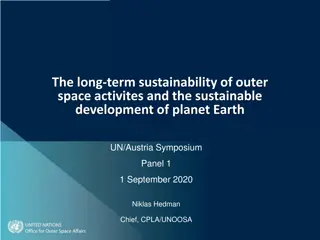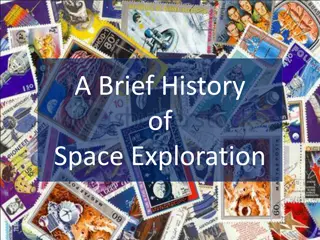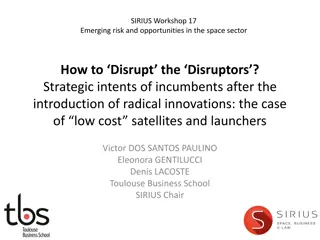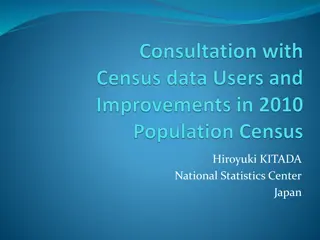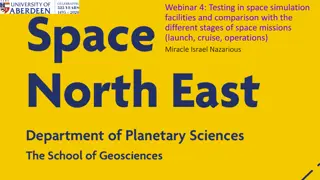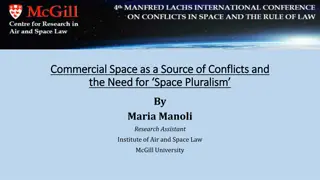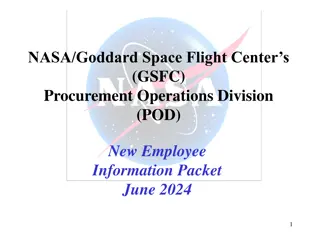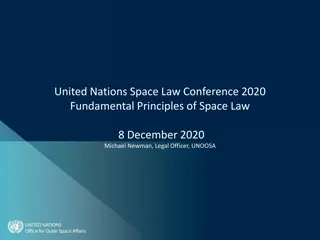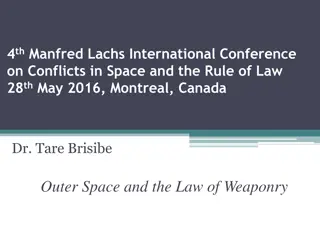Exploring Space: From Yuri Gagarin to Modern Innovations
Discover the fascinating journey of space exploration from Yuri Gagarin's historic flight as the first man in space to modern innovations like the V-2 Rocket and the development of the Karman Line. Dive into key events such as the launch of the first intercontinental ballistic missile (ICBM) and the milestones in satellite technology. Join us for engaging discussions, presentations, and a fun Space Exploration Jeopardy session with prizes at the International Space Development Conference (ISDC).
Download Presentation

Please find below an Image/Link to download the presentation.
The content on the website is provided AS IS for your information and personal use only. It may not be sold, licensed, or shared on other websites without obtaining consent from the author. Download presentation by click this link. If you encounter any issues during the download, it is possible that the publisher has removed the file from their server.
E N D
Presentation Transcript
Agenda 6:00 -Gathering/Opening Activity 6:15 -Yuri's Gagarin First Man in Space 6:30 Discussion/ Pizza 6:45 -Presentation on HOTOL/Skylon/ Sabre engine (Doug) 7:00 -Discussion 7:15 International Space Development Conference (ISDC) 7:30 -Discussion 7:45 -Space Exploration Jeopardy with prizes
Yuri Gagarin Events before the first man in space About the first man in space and his flight Events after the first man in space
V-2 Rocket - The V-2 was the world's first long-range guided ballistic missile. The missile, powered by a liquid-propellant rocket engine, was developed during the Second World War in Germany as a "vengeance weapon", assigned to attack Allied cities as retaliation for the Allied bombings against German cities. The V-2 rocket also became the first man- made object to travel into space by crossing the K rm n line with the vertical launch of MW 18014 on 20 June 1944.
The Krmn line, or Karman line, lies at an altitude of 100 km (62 mi; 330,000 ft) above Earth's sea level and commonly represents the boundary between Earth's atmosphere and outer space.[2] This definition is accepted by the F d ration A ronautique Internationale (FAI), which is an international standard-setting and record-keeping body for aeronautics and astronautics. Karman line 100 km (62 mi; 330,000 ft) above Earth's sea level Official division between atmosphere and Space
Date 21-Aug-57 First intercontinental ballistic missile (ICBM) Significance R-7 Semyorka 4-Oct-57 First artificial satellite Sputnik 1 First signals from space 3-Nov-57 First dog in orbit (Laika) Sputnik 2 31-Jan-58 First US satellite, detection of Van Allen radiation belts Explorer 1- ABMA 17-Mar-58 First solar powered satellite Vanguard 1-NRL Project SCORE-ABMA 18-Dec-58 First communications satellite 2-Jan-59 First rocket engine restart in Earth orbit First lunar spacecraft First detection of solar wind First human-made object in heliocentric orbit Luna 1 4-Jan-59 Luna 1
Date 17-Feb-59 First weather satellite 28-Feb-59 First satellite in a polar orbit 25-Jun-59 First spy satellite to carry a camera (failed to achieve orbit) 7-Aug-59 First photograph of Earth from orbit 14-Sep-59 First impact into another celestial body (Moon) Significance Vanguard 2-NASA(NRL)1 Discoverer 1-USAF/ARPA Discoverer 4-USAF/ARPA Explorer 6-NASA Luna 2 7-Oct-59 1-Apr-60 First photos of far side of the Moon First Imaging weather satellite Luna 3 TIROS-1-NASA 5-Jul-60 First successful US spy satellite (returned intelligence data) 11-Aug-60 First satellite recovered intact from orbit 12-Aug-60 First passive communications satellite 18-Aug-60 First successful recovery of film from an orbiting satellite First aerial recovery of an object returning from Earth orbit 19-Aug-60 First animals and plants returned alive from space (Belka and Strelka) GRAB-1-NRL Discoverer 13- USAF/ARPA Echo 1A-NASA Discoverer 14- USAF/ARPA Sputnik 5
Date 12-Feb-61 Significance First launch from Earth orbit of upper stage into a heliocentric orbit First mid-course corrections First spin-stabilisation First human spaceflight (Yuri Gagarin) First orbital flight of a manned vehicle Venera 1 12-Apr-61 Vostok 1
Biography: Yuri Gagarin, cosmonaut Born: 9 March 1934 Birthplace: Klushino, Russia Died: 27 March 1968 (airplane crash) Best Known As: The first human in space Presention created by: Vlad Florea
Early life Yuri Gagarin was born in the village of Klushino near Gzhatsk (now in Smolensk Oblast, Russia), on 9 March 1934. The adjacent town of Gzhatsk was renamed Gagarin in 1968 in his honor. His parents, Alexei Ivanovich Gagarin and Anna Timofeyevna Gagarina, worked on a collective farm.
Early life Like all people his age Gagarin had to undergo the ordeals of the war years. He was seven, when the Second World War broke out. The boy survived the Nazi invasion, the severe hardships of the war. The first planes he saw were war planes.
Early life When the war ended the Gagarin family moved to Gzhatsk. Yuri attended an elementary school in this town.
Early life Gagarin briefly attended a trade school to learn foundry work in the Moscow satellite town of Lyubertsy, then entered a technical school. He joined the Saratov Flying Club in 1955 and learned to fly the Yak-18.
Early life Later that year, he was drafted and sent to the Orenburg Flying School, where he trained in the MIG jet. Gagarin graduated November 7, 1957, four days after Sputnik 2 was launched. He married Valentina Goryacheva, a nursing student, the day he graduated.
Career in the Soviet space program Selection and training Post-graduation, he was assigned to Luostari airbase in Murmansk Oblast, close to the Norwegian border, where terrible weather made flying risky. In 1958 space officials recruited air force pilots to train as cosmonauts.
Career in the Soviet space program Selection and training Gagarin applied and was selected to train in the first group of sixty men. Only twelve men were taken for further training at Zvezdograd (Star City), a training field outside Moscow.
Career in the Soviet space program Selection and training Space officials closely observed the trainees. They finally selected Gagarin for the first spaceflight. Capable, strong, and even-tempered, Gagarin represented the ideal Soviet man, a peasant farmer who became a highly trained cosmonaut in a few short years.
Career in the Soviet space program Space flight He was launched in Vostok 1 on the planned date, and during the crowded 1 hour 48 minutes of his single orbit of the earth he proved that man could survive in space and perform useful tasks. His mission ended at 10:55 A.M., when he landed safely in a field near Saratov
Career in the Soviet space program Fame and later life After the flight, Gagarin became a worldwide celebrity, touring widely with appearances in Italy, Great Britain, Germany, Canada, and Japan to promote the Soviet achievement.
Career in the Soviet space program Fame and later life In 1962, he began serving as a deputy to the Supreme Soviet. He later returned to Star City, the cosmonaut facility, where he worked on designs for a reusable spacecraft. Gagarin worked on these designs in Star City for 7 years.
Death and legacy On 27 March 1968, while on a routine training flight, he and flight instructor Vladimir Seryogin died in a MiG-15UTI crash near the town of Kirzhach. Gagarin and Seryogin were buried in the walls of the Kremlin on Red Square.
Death and legacy American astronauts Neil Armstrong and Edwin Aldrin left one of Gagarin's medals on the moon as a tribute. The cosmonaut training center where he had first trained was named after him. A crater on the moon bears his name, as does Gagarin Square in Moscow with its soaring monument, along with a number of monuments and streets in cities throughout Russia. At Baikonur, a reproduction of his training room is traditionally visited by space crews before a launch. Russians celebrate Cosmonaut Day on April 12 every year in honor of Gagarin's historic flight.
Date 5-May-61 Significance First pilot-controlled space flight (Alan Shepard) First human space mission that landed with pilot still in spacecraft and thus the first complete human spaceflight by FAI definitions First planetary flyby (Venus) Freedom 7 19-May-61 Venera 1 6-Aug-61 20-Feb-62 First crewed mission lasting a full day. First American to Orbit the Earth - John Glenn First orbital solar observatory First spacecraft to impact the far side of the Moon. First active communications satellite First dual crewed spaceflight First ship-to-ship radio contact and First simultaneous flight of crewed spacecraft First artificial satellite constructed by a non-superpower First planetary flyby by a US mission (Venus) Vostok 2, Gherman Titov Friendship 7 7-Mar-62 26-Apr-62 OSO-1-NASA Ranger 4-NASA 10-Jul-62 12-Aug-62 Telstar-AT&T Vostok 3 / Vostok 4, Andriyan Nikolayevand Pavel Popovich 29-Sep-62 Canada Alouette 1 14-Dec-62 Mariner 2-NASA
Date 16-Jun-63 Significance First woman in space (Valentina Tereshkova) First civilian in space Five-day human spaceflight record First reusable piloted spacecraft and the first spaceplane(X-15, suborbital) First geosynchronous satellite First satellite navigation system First geostationary satellite First multi-person crew (3) First extra-vehicular activity ("space walk") First piloted spacecraft orbit change First Mars flyby Eight-day human spaceflight record First orbital rendezvous (station- keeping, no docking) 14-day human spaceflight record Vostok 6 19-Jun-63 19-Jul-63 Vostok 5 X-15 Flight 90-NASA 26-Jul-63 5-Dec-63 19-Aug-64 12-Oct-64 18-Mar-65 Syncom 2-NASA NAVSAT-USN Syncom 3-NASA Voskhod 1 Voskhod 2 23-Mar-65 14-Jul-65 29-Aug-65 15-Dec-65 Gemini 3-NASA Mariner 4-NASA Gemini 5-NASA Gemini 6A / Gemini 7-NASA 18-Dec-65 Gemini 7-NASA Date 16-Jun-63 Significance First woman in space (Valentina Tereshkova) First civilian in space Five-day human spaceflight record First reusable piloted spacecraft and the first spaceplane(X-15, suborbital) First geosynchronous satellite First satellite navigation system First geostationary satellite First multi-person crew (3) First extra-vehicular activity ("space walk") First piloted spacecraft orbit change First Mars flyby Eight-day human spaceflight record First orbital rendezvous (station- keeping, no docking) 14-day human spaceflight record Vostok 6 19-Jun-63 19-Jul-63 Vostok 5 X-15 Flight 90-NASA 26-Jul-63 5-Dec-63 19-Aug-64 12-Oct-64 18-Mar-65 Syncom 2-NASA NAVSAT-USN Syncom 3-NASA Voskhod 1 Voskhod 2 23-Mar-65 14-Jul-65 29-Aug-65 15-Dec-65 Gemini 3-NASA Mariner 4-NASA Gemini 5-NASA Gemini 6A / Gemini 7-NASA 18-Dec-65 Gemini 7-NASA
Date 3-Feb-66 Significance First soft landing on another celestial body (Moon) First photos from another celestial body First impact into another planet (Venus) Venera 3 First spacecraft docking First artificial satellite to orbit another celestial body: the Moon First direct-ascent rendezvous on first orbit Record highest apogee, 1,374 kilometers (854 mi), for piloted Earth First 5.5 hr extra-vehicular activity Luna 9 1-Mar-66 16-Mar-66 3-Apr-66 Gemini 8 / ATV-NASA Luna 10 12-Sep-66 Gemini 11/ATV-NASA November 12 14, 1966 Gemini 12-NASA First demonstration of practical work capability First docking of two remote-controlled spacecraft First orbital ultraviolet observatory First human-crewed spaceflight to, and orbit of, another celestial object: the Moon First human spaceflight that escaped Earth's influence First crew exchange in space 30-Oct-67 Cosmos 186/ Cosmos 188 7-Dec-68 21-Dec-68 OAO-2-NASA Apollo 8-NASA 16-Jan-69 Soyuz 4 / Soyuz 5 20-Jul-69 First humans on the Moon First space launch from another celestial body Apollo 11-NASA
ISDC http://ISDC2018.nss.org
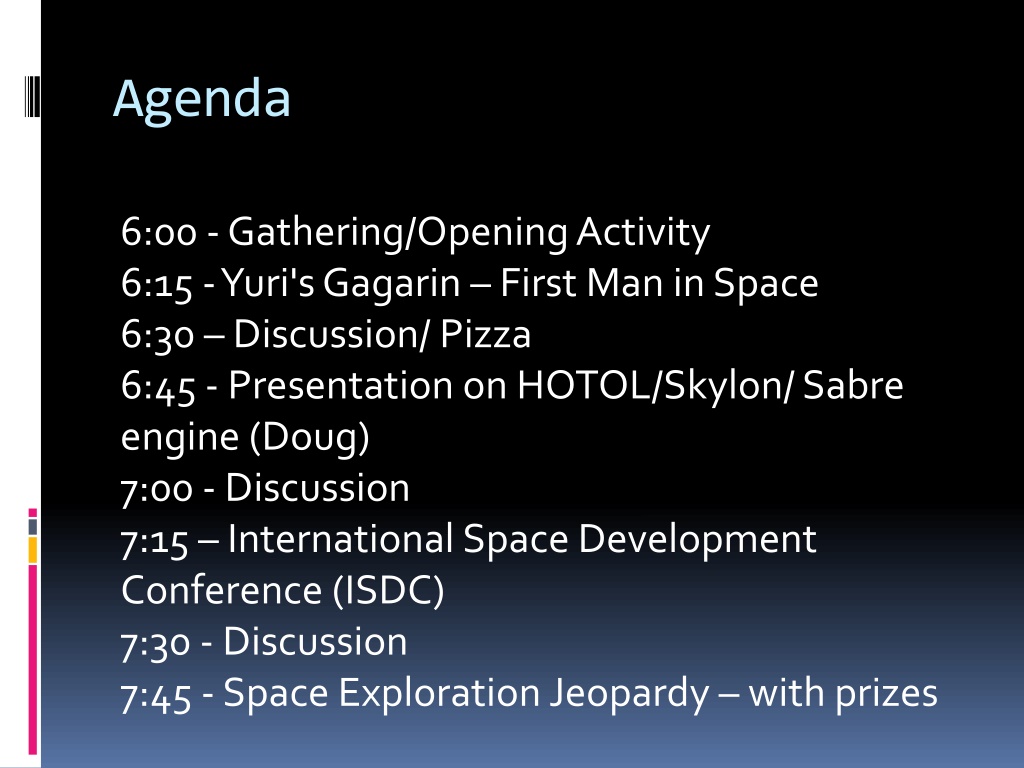


![Read⚡ebook✔[PDF] Linking the Space Shuttle and Space Stations: Early Docking Te](/thumb/21519/read-ebook-pdf-linking-the-space-shuttle-and-space-stations-early-docking-te.jpg)
![READ⚡[PDF]✔ Emerging Space Powers: The New Space Programs of Asia, the Middle Ea](/thumb/21554/read-pdf-emerging-space-powers-the-new-space-programs-of-asia-the-middle-ea.jpg)



